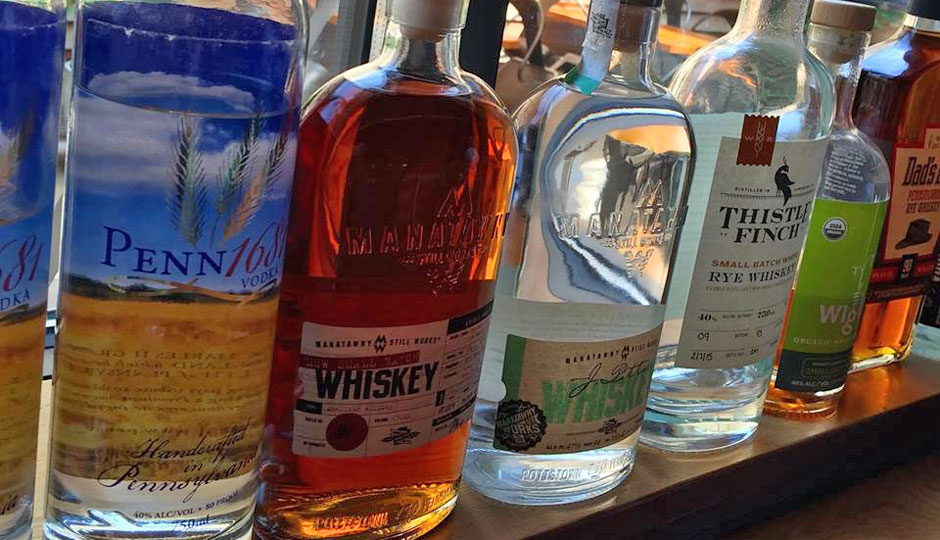The American Whiskey Convention in Philadelphia was a bit of an inspiration for me to spend a bit more time discussing the boom in whiskey distilling here in Pennsylvania. The “White Dog Row” element of the Convention showed off 11 new make spirits from 8 different local distilleries. White whiskey is the backbone of any distillery. It shows the character of the grain, the flavors contributed by the yeasts and the potential of the spirit. No amount of aging can fix a bad white whiskey foundation. I think it was important to highlight the potential of our local distilleries through their white dogs. It also gave a chance for the distillers and representatives from those distilleries to speak directly to the public about their work and their visions for the future, not to mention offer tastes of their foundational product.
I’m going to spend the next few days talking about some of the new micro-distilleries that have become a force of change in the Keystone State. The origin story behind this new whiskey distilling trend in Pennsylvania began with the passing of Act 113 in 2011. The following became possible:
- Distilleries could sell bottles to the public between 9am and 11pm, though never at lower prices than what the PA Wine and Spirits stores charge for the same product.
- They may operate up to two satellite locations.
- They may operate a dispenser license to sell alcoholic beverages out of the location.
- Liquor sold on premises must be made on premises.
- They may offer tastings, as long as the total amount given to one person does not exceed 1 ½ ounces.
Distilleries that were smaller producers (under 100,000 gallons) of liquor could reregister under the “Limited Distillery License” and begin to sell their product. Before this law, distilling whiskey was only possible for the very well-financed that could afford to throw money at a business without income for years while their product aged. Even then, there was no sure way to know that your product would be accepted and would sell well after the whiskey was ready. This new license allowed for interaction with a distillery’s potential clients and buyers and gave them a chance to make income while their stocks sat in barrels. White dog whiskey (unaged whiskey) began showing up on shelves and cocktail mixologists began incorporating that new unaged spirit into their creations. (Though most whiskey drinkers that prefer their drink “neat” don’t tend to want anything to do with white dog, the fact is that it is a more flavorful option than vodka and does work well in mixers.) Whiskey distilleries were finally seeing options and could survive through the tough first few years.
We are living in those first few years right now. Even if a distillery opened immediately after the law passed, they would still have very young whiskey. Dad’s Hat Rye, the pride of the Philadelphia suburbs, was opened in 2010 and their oldest whiskey, which is only three years old, has not been bottled yet. The new whiskey makers in PA are forced to use smaller barrels to rush their product along. Smaller barrels alter the process of aging by allowing more interaction of the white dog with the wood- a higher wood to distillate ratio. This doesn’t allow for the nuanced aging process to happen over a long period of time as most distillers will tell you is necessary, but it does allow a young whiskey to be brought to market. Some whiskeys have been successful with the use of small barrels, but the end game for most new distilleries is the same- They eventually want to have a straight whiskey that they are proud of.
New micro-distilleries will make white spirits like gin or vodka even if they opened the distillery to make whiskey. Gin, white rum, silver tequila, vodka and white dog whiskey come right off the still and can be bottled for sale, which is a much more lucrative proposition than waiting four years to produce a good whiskey. Every new distillery will have to play with their recipes and tweak their aging processes until they determine what works best for them. I personally want to see all of these young distillers succeed because I hope to see more competition in the whiskey market. Experimentation isn’t just fun for the distillers, it’s fun for the consumers! What does a triticale whiskey with a red corn flavoring grain taste like? What would an aged wheated rye whiskey taste like? What would an American oat whiskey taste like? I can’t wait to find out what these new distilleries will do next!

